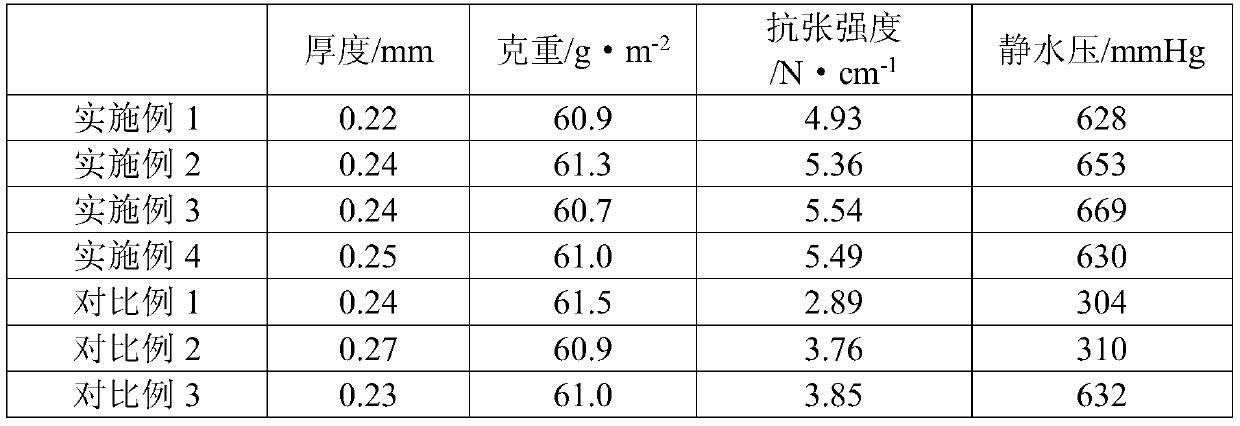High-strength hydrophobic non-woven fabric and preparation method thereof
A hydrophobic, non-woven fabric technology, applied in the field of non-woven fabrics, can solve the problems of poor durability of hydrophobic fabrics, easy to fall off, affect the hydrophobicity of fabrics, etc., achieve good durability and improve strength
- Summary
- Abstract
- Description
- Claims
- Application Information
AI Technical Summary
Problems solved by technology
Method used
Image
Examples
Embodiment 1
[0042] A kind of non-woven fabric is prepared by the following method:
[0043] (1) prepare tris-methyl acrylate-dipentaerythritol copolymer, concrete process is as follows:
[0044] (1.1) Addition reaction: Add 5.2g of trishydroxymethylaminomethane into 10mL of 50% methanol aqueous solution (50% methanol aqueous solution means the volume fraction of methanol is 50%), heat up to 30°C, stir and dissolve; dropwise add 5.2g A mixed solution of methyl acrylate and 10 mL of methanol was reacted at 30°C for 2 hours; after the reaction was completed, methanol, water and excess methyl acrylate were removed by vacuum to obtain the addition reaction product;
[0045] (1.2) Transesterification reaction: Add 1.3g of dipentaerythritol into 10mL of dimethyl sulfoxide, heat up to 90°C, stir to dissolve; add dropwise the addition reaction product obtained in step (1.1), heat up to 125°C, and react for 2h , and then reacted at 100°C and 0.08MPa for 2h; after the reaction was completed, dimeth...
Embodiment 2
[0055] A kind of non-woven fabric is prepared by the following method:
[0056] (1) prepare tris-methyl acrylate-dipentaerythritol copolymer, concrete process is as follows:
[0057] (1.1) Addition reaction: add 6.5g of trishydroxymethylaminomethane into 10mL of 50% aqueous methanol solution (50% aqueous methanol solution means the volume fraction of methanol is 50%), heat up to 33°C, stir and dissolve; add 7.8g of A mixed solution of methyl acrylate and 12 mL of methanol was reacted at 33°C for 2.5 hours; after the reaction was completed, methanol, water and excess methyl acrylate were removed by vacuum to obtain the addition reaction product;
[0058] (1.2) Transesterification reaction: Add 1.7g of dipentaerythritol into 10mL of dimethyl sulfoxide, heat up to 95°C, stir to dissolve; add dropwise the addition reaction product obtained in step (1.1), heat up to 127°C, and react 2.5 h, and then reacted at 105°C and 0.06MPa for 2h; after the reaction was completed, dimethyl sul...
Embodiment 3
[0068] A kind of non-woven fabric is prepared by the following method:
[0069] (1) prepare tris-methyl acrylate-dipentaerythritol copolymer, concrete process is as follows:
[0070] (1.1) Addition reaction: Add 7.2g of trishydroxymethylaminomethane into 15mL of 50% aqueous methanol solution (50% aqueous methanol solution means the volume fraction of methanol is 50%), heat up to 35°C, stir and dissolve; add 10.8g of A mixed solution of methyl acrylate and 15 mL of methanol was reacted at 35°C for 3 hours; after the reaction was completed, methanol, water and excess methyl acrylate were removed by vacuum to obtain an addition reaction product;
[0071] (1.2) Transesterification reaction: Add 2 g of dipentaerythritol into 10 mL of dimethyl sulfoxide, heat up to 100° C., stir to dissolve; add dropwise the addition reaction product obtained in step (1.1), heat up to 130° C., and react for 3 hours. Then react at 110°C and 0.05MPa for 2.5 hours; after the reaction is completed, dim...
PUM
 Login to View More
Login to View More Abstract
Description
Claims
Application Information
 Login to View More
Login to View More - R&D
- Intellectual Property
- Life Sciences
- Materials
- Tech Scout
- Unparalleled Data Quality
- Higher Quality Content
- 60% Fewer Hallucinations
Browse by: Latest US Patents, China's latest patents, Technical Efficacy Thesaurus, Application Domain, Technology Topic, Popular Technical Reports.
© 2025 PatSnap. All rights reserved.Legal|Privacy policy|Modern Slavery Act Transparency Statement|Sitemap|About US| Contact US: help@patsnap.com

